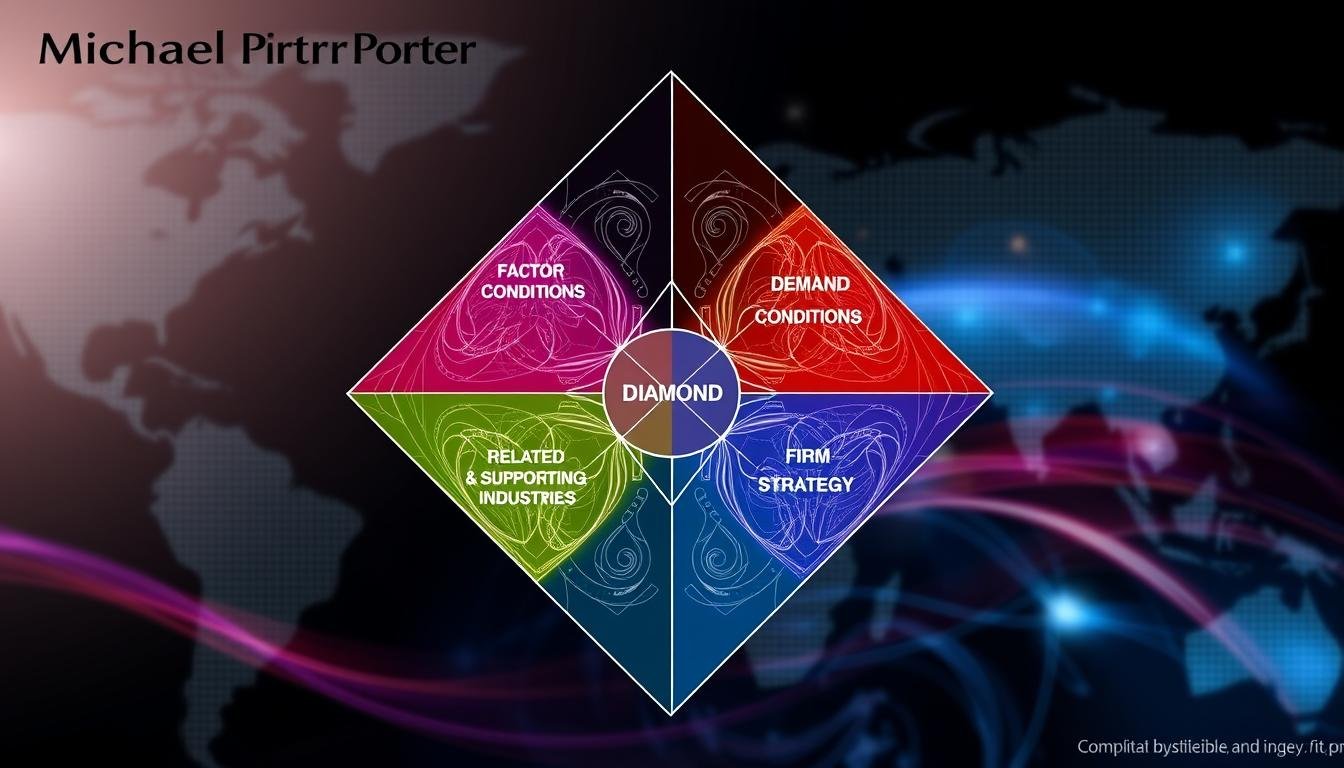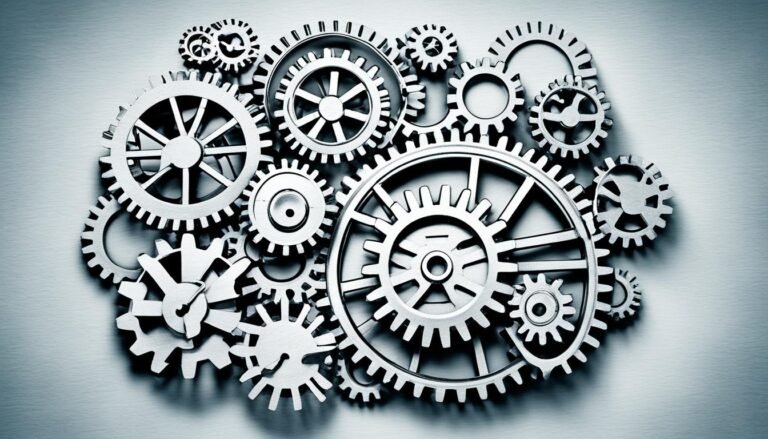Exploring the Facets of Michael Porter’s Diamond Model
Ever wondered why some countries do better than others in the global market? It’s all thanks to Michael Porter’s Diamond Model. This model has changed how we see international competition. It shows how different national factors work together to create a competitive edge.
In this article, we’ll dive into the main parts of Porter’s model. We’ll also look at its history and how it helps with business strategy and economic growth.
Key Takeaways
- Michael Porter’s Diamond Model identifies four essential components influencing national competitive advantage.
- The model emphasizes the importance of demand conditions in fostering innovation within industries.
- It highlights how related and supporting industries contribute to a stronger competitive landscape.
- Firm strategy, structure, and rivalry are crucial in enhancing productivity and performance.
- Understanding factor conditions can lead to effective resource utilization and competitive advantages.
- The Diamond Model offers valuable insights for businesses aiming to enter new markets successfully.
Understanding the Basics of Porter’s National Diamond
Porter’s Diamond Model is key for looking at what makes a country competitive. Michael Porter created it to help countries boost their industries by focusing on their strengths. The model looks at several important areas like how companies work, demand, related industries, and the skills of workers. These factors are crucial for a country’s success in the global market.
Definition and Purpose of the Diamond Model
The Diamond Model helps analyze what gives a country a competitive edge. It’s shaped like a diamond, with each side showing a key factor that affects the economy. By using this model, countries can see their strong points and areas to improve. For example, having a strong tech sector or skilled workers can really help a country compete.
Historical Context of its Development
Michael Porter created the Diamond Model in the late 20th century when global competition was growing. It was a new way to help countries improve their industries. The model shows how things like skilled workers and good infrastructure can give a country an edge. For example, Japan’s focus on engineering education helped it become a leader in tech innovation.
The Four Key Components of Michael Porter’s Diamond Model
Michael Porter’s Diamond Model helps us understand a nation’s competitive edge. It has four main parts: factor conditions, demand conditions, related and supporting industries, and firm strategy, structure, and rivalry. Each part is key to building a strong competitive advantage and a solid business strategy.
Factor Conditions: The Importance of Resources
Factor conditions look at the resources a country has, like skilled workers, technology, and infrastructure. These are vital for success in industries. Countries that focus on improving their people’s skills, like Singapore, do much better economically.
They have a higher GDP per person than countries that don’t focus on these areas. Good infrastructure also helps with innovation and productivity. This gives them an edge over countries with less.
Demand Conditions: Consumer Behavior and Market Size
Demand conditions show how consumers behave and what they want. A strong local demand pushes businesses to be creative and grow. For example, Boeing grew globally by meeting local needs first.
Companies in areas with big demand can get ahead by understanding what customers want. They can make better products and strategies because of this.
Related and Supporting Industries: Collaborations that Drive Success
Related and supporting industries are about how businesses work together. Having good suppliers helps the main industry innovate and meet market needs. Apple works with suppliers to bring out new tech and products, staying ahead.
Firm Strategy, Structure, and Rivalry: Competition as a Catalyst
Competition is key to making firms better and more innovative. It pushes companies to improve their models. Governments can help create a competitive environment, keeping firms on their toes.
How Michael Porter’s Diamond Model Explains Competitive Advantage
Michael Porter’s Diamond Model helps us understand how countries get ahead. It shows how unique things about a country help it grow economically. This is key to seeing why some places and sectors do better than others.
Mechanisms of Competitive Advantage in Different Nations
Each country uses its own strengths to succeed. For example, Singapore has a high GDP per capita of $90,000 thanks to skilled workers and tech readiness. On the other hand, Venezuela’s GDP per capita is $11,000, showing how different factors can affect economic success.
This difference fits with the idea of international competitiveness theory. It shows how skilled workers and good infrastructure are crucial for economic growth.
Case Studies Illustrating Regional Success
Looking at Apple in tech shows how supporting industries is key. Apple does well because of its strong suppliers and innovative products. This fits with Porter’s Diamond Model.
Another example is the aerospace sector, where Boeing did well. Boeing’s success shows how local demand helps industries grow. These examples prove how the model works in real life to understand competitive advantages.
The Role of Government Policies in Shaping Competitive Landscapes
Government policies greatly affect competition. In the U.S., laws against unfair competition help companies stay healthy. In 1998, the U.S. even thought about breaking up Microsoft to stop it from dominating too much.
This kind of regulation helps create strong competition at home. It leads to more innovation and efficiency, which are important for economic growth. Porter’s model shows how government actions shape industries, making it useful for understanding today’s markets.
Applying the Diamond Model in Business Strategy
Michael Porter’s Diamond Model helps improve business strategy, especially in entering new markets and innovating. It gives a clear way for companies to understand local markets and their place in them. By using this model, businesses can learn a lot about their own strategy and the market they’re in.
Using the Model for Market Entry Decisions
Companies wanting to enter new markets can use the Diamond Model to look at what makes competition fierce. Knowing about factor conditions, like skilled workers and good infrastructure, helps check if a market is right. Also, looking at demand conditions shows what customers like, helping businesses know what products to make.
By checking out related and supporting industries, companies can find chances to work with strong suppliers. This boosts their edge in the market.
Strategic Analysis and Innovation Guidance
The Diamond Model is great for sparking innovation in companies. Leaders can use its insights to better their firm strategy, structure, and rivalry. Creating a place where innovation thrives means knowing what customers want and who can help you.
For example, IKEA changes its strategies based on what customers say and what the market needs. This shows how looking closely at the market can lead to growth and success.
| Component | Description | Impact on Competitive Advantage |
|---|---|---|
| Factor Conditions | Availability of resources such as skilled labor and capital | Enhances efficiency and innovation capacity |
| Demand Conditions | Consumer preferences and demands in the local market | Drives product development and improvement |
| Related and Supporting Industries | Competitive suppliers and related sectors | Facilitates collaboration for enhanced performance |
| Firm Strategy, Structure, and Rivalry | Competitive positioning and management structure | Encourages innovation through competition |
Limitations and Critiques of the Diamond Model
Porter’s Diamond Model has given us deep insights into the economy. But, it has its limits when applied today. It looks at four main factors: factor conditions, demand conditions, related industries, and firm strategy. Critics say it might not capture the full picture of today’s fast-changing global trade.
Potential Oversights in Global Trade Dynamics
The global economy is always changing, with new tech and shifts in politics. Porter’s Diamond Model might miss these changes. This means it could miss how countries compete in the world. Critics say the model needs updates to include things like:
- Geopolitical shifts that change trade ties.
- Technological advancements that change how we make and run things.
- Evolution of supply chains and international partnerships.
Criticism of the Model in Modern Economic Scenarios
International business keeps evolving, and Porter’s Diamond Model might need to adapt. Some say:
- It doesn’t include national culture, which is important for understanding competition.
- Chance events and government policies have big impacts, but the model might not fully capture them.
- The data used in the model might not be detailed enough for certain industries.
The Diamond Model is a key part of economic theory, but it could be better. Adding cultural aspects, like Hofstede’s ideas, could make it more useful in different markets.
| Critique | Description | Suggested Adjustment |
|---|---|---|
| Global Trade Dynamics | Overlooks geopolitical shifts and tech advancements | Incorporate global factors into analysis |
| National Culture | Neglects cultural influences on competitive advantage | Integrate Hofstede’s dimensions |
| Chance Events | May not fully account for unexpected changes | Emphasize the impact of policies and events |
| Data Limitations | Lacks comprehensive industry histories | Gather detailed, diversified data for insights |
Conclusion
Michael Porter’s Diamond Model is key to understanding how countries gain an edge in different industries. It was first introduced in 1990 as a main idea in “The Competitive Advantage of Nations.” The model looks at four main parts: Factor Conditions, Demand Conditions, Related and Supporting Industries, and Firm Strategy, Structure, and Rivalry.
For example, Japan’s car industry shows how countries can succeed worldwide even with limited natural resources. They did this by investing in skilled workers and technology. The model also shows the value of working with other industries, like Nissan did with local manufacturers.
Government policies, like the U.S. stance on Huawei, show how outside forces can affect a country’s competitiveness. Michael Porter’s Diamond Model helps companies, big or small, understand how to compete. It’s still useful today, helping with strategic plans, government decisions, and growth in industries.
Source Links
- The Diamond Model of Michael Porter & its implication on medical tourism in India
- Porters Diamond – Determining Factors of National Advantage
- Strategy Frameworks for Business Designers – Michael Porter’s Diamond Model Explained | Untaylored
- Porter Diamond Model: What It Is and How It Works
- Porter’s Diamond Model EXPLAINED with EXAMPLES | B2U
- The Diamond Model: Understanding Competitive Advantage in Business
- Articles | Porter’s Diamond Model and the Competitive Advantage
- Diamond Model & Competitive Advantage of Nations
- The Diamond Model Theory: Shaping the Future of National Competitiveness
- Porter Diamond Model
- Evaluation of Porter’s Diamond Model – MBA Knowledge Base
- Porter’s Diamond Model analysis: Louis Vuitton and BMW
- Challenges And Limitations Of The Porter Diamond Model In Driving Economic Growth – FasterCapital
- Analysis of Porter’s Diamond Model of National Advantage – MBA Knowledge Base
- Porter’s Diamond Model: An Essential Guide for Global Achievement
- Porter’s Diamond Model







